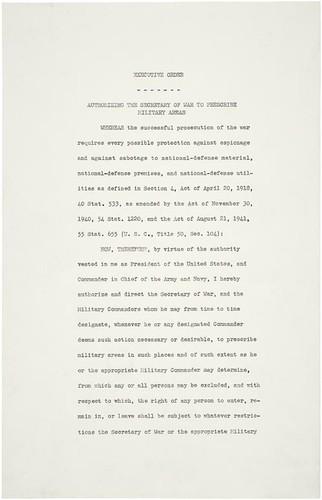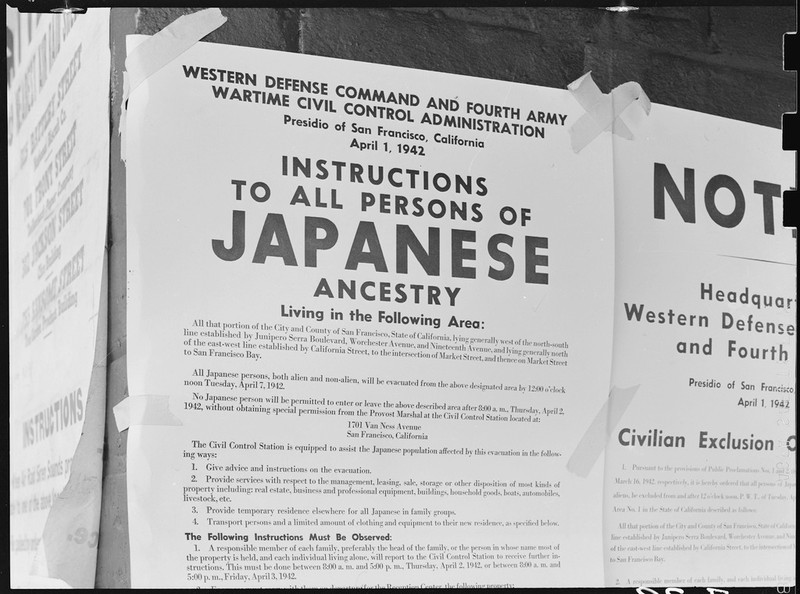Executive Order 9066
Introduction
Text-to-speech Audio
President Franklin D. Roosevelt, as many presidents before him, made difficult decisions throughout his presidency. However, his decisions were impacted by the eruption of a second world war. President Roosevelt issued Executive Order 9066 in 1942, and the Oval Office within the White House symbolizes the time he would have spent weighing this decision.
Capitalizing on the fear and outrage that erupted after the Pearl Harbor attack, President Franklin D. Roosevelt issued Executive Order 9066 on February 19, 1942, displacing and incarcerating Japanese Americans in detention centers located outside of the West coast (Executive Order 9066). Over 100,000 Japanese Americans were forcibly removed from their homes, losing their livelihoods, many possessions, and their American identities (Executive Order 9066). The historically held idea of Japanese immigrants’ inability to assimilate to American culture and thus never become an American citizen permeated many narratives, and suspicion fueled perceptions of Japanese Americans for many white Americans. As historian Lon Kurashige explains, even President Roosevelt held the notion that:
"Japanese are unassimilable with whites" (Kurashige 170).
Furthermore, as Brian Masaru Hayashi described, while perceived “military necessity” served as the formal factor of Japanese incarceration, public sentiment against the Japanese and Japanese Americans also fueled the decision (Hayashi 78-79). Although public opinion had many cases of hatred towards Japanese Americans, public opposition to the incarceration of Japanese Americans emerged. However, opposition to the events did not always equate to support of Japanese Americans as trustworthy citizens. In fact, historian Lon Kurashige emphasized that, even among West Coast white Americans,
"many of those who saw them [Japanese Americans] as loyal admitted that they remained suspicious of Japanese Americans because it was difficult to tell the loyal from the disloyal" (Kurashige 172).
According to historian Greg Robinson,
"apart for the hearings, few commentators outside the West Coast paid much attention, positive or negative, to the military orders and the implementation of removal plans on the West Coast" (Robinson 108).
The various regions of the United States became involved in the incarceration narrative as Order 9066 relocated Japanese Americans from the West Coast further inland. While Missouri did not have a designated Japanese American incarceration camp, Kansas Citians and surrounding citizens experienced the impact of the Order firsthand through the actions of local academic institutions, including Park College.
Images
Transcript of Executive Order 9066, Feb. 19, 1942

Instructions posted for those with Japanese Ancestry in the United States after the issuance of Executive Order 9066

Backstory and Context
Text-to-speech Audio
Sources
Daniels, Roger. Asian America: Chinese and Japanese in the United States Since 1850. Seattle: University of Washington Press, 1988.
Dower, John W. War without Mercy: Race and Power in the Pacific War. Pantheon Books, 1986.
“Executive Order 9066: Resulting in Japanese-American Incarceration (1942).” National Archives. Accessed Nov. 30, 2022, https://www.archives.gov/milestone-documents/executive-order-9066.
Ford, Ardyn. “Japanese Internment Camps as a Threat to American Exceptionalism.” Hinckley Journal of Politics 23 (January 2022): 19–27.
Hayashi, Brian Masaru. Democratizing the Enemy: The Japanese American Internment. Princeton, N.J.: Princeton University Press, 2008.
Kurashige, Lon. Two Faces of Exclusion: The Untold History of Anti-Asian Racism in the United States. Chapel Hill: The University of North Carolina Press, 2016.
Robinson, Greg. A Tragedy of Democracy: Japanese Confinement in North America. New York: Columbia University Press, 2009.
Executive Order 9066, February 19, 1942; General Records of the United States Government; Record Group 11; National Archives. https://www.archives.gov/milestone-documents/executive-order-9066
"Posted exclusion orders," Densho ID#: ddr-densho-151-76, Densho Digital Repository. Courtesy of the National Archives and Records Administration. https://ddr.densho.org/ddr-densho-151-76/
